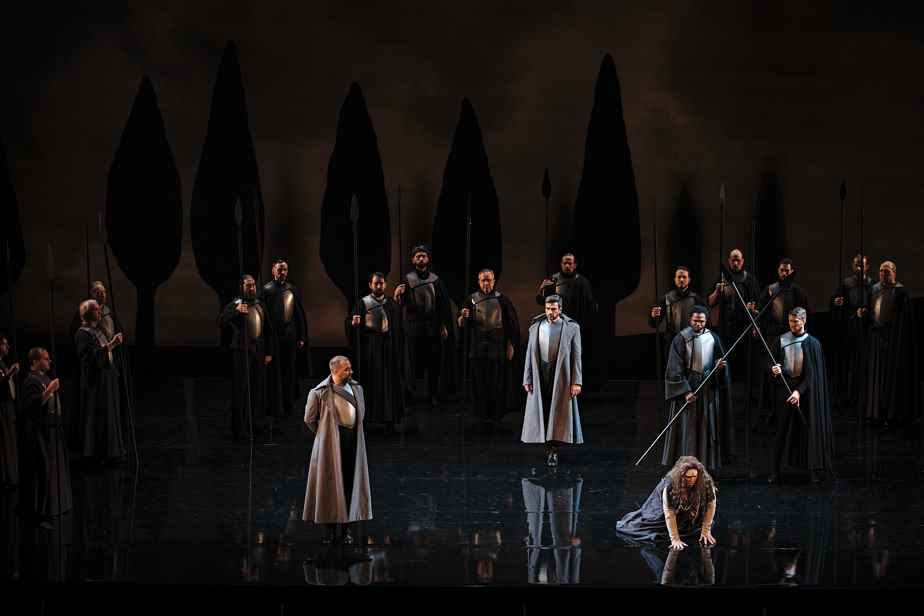The Opéra de Montréal inaugurated its 2022-2023 season on Saturday evening with the premiere ofHe trovatore of Verdi at Salle Wilfrid-Pelletier. A show of a beautiful outfit despite some flats on the vocal level.
Posted at 9:00 a.m.
This flagship work of the Verdian repertoire – it forms a blessed trilogy with Rigoletto and The traviata – had been staged the last time in the metropolis in 2012, a show that our late colleague Claude Gingras had described as “good, beautiful, inexpensive” because of the simplicity of the scenic device.
Jean Bard’s current sets, combined with Eric Champoux’s subtle lighting, did not have to empty the institution’s coffers either: a large inclined plane lined with a reflective surface allows the protagonists to move in front of the rear – evocative plans. From time to time, a piece of scenery (a series of arches, a balustrade, etc.) descends from the hangers and is enough to transport us to the scene of the action.
The house costumes, matching medieval breastplates with dresses and overcoats from a time much closer to our own, blend in well with the ensemble, especially Leonora’s gorgeous mustard yellow dress in the first act.
Michel-Maxime Legault’s staging is no less effective, except for a few questionable ideas in the choir (movements of spears or sticks that are a bit too systematic…).
But He trovatore, they are first of all voices. We don’t come here for the story, one of the most quirky in the history of opera.
First there is the couple formed by the baritone Étienne Dupuis and his wife, the Australian soprano Nicole Car, who made a strong impression three years ago in Eugene Onegin by Tchaikovsky.

PHOTO VIVIEN GAUMAND, PROVIDED BY THE PRODUCTION
Nicole Car, Australian soprano, in He trovatore
The first deploys his splendid voice in the role of Count de Luna. We would have taken more flesh in his unique air, Il balen del suo sorriso, but the singer seems to have deliberately wanted to make it more intimate. We are also surprised by the general sobriety of his playing, he who is used to taking over the stage.
Nicole Car is perhaps a little out of place as Leonora. Not that the singing isn’t beautiful. He is ! But we are not in The traviata, which is more of a “chamber opera”. These are Maria Callas, Zinka Milanov and Leontyne Price who are among the great holders of the role. So you need a great dramatic soprano more than a Marguerite or a Juliette.
The most perilous role is undoubtedly that of Manrico. Abitibi tenor Luc Robert certainly has an exceptional timbre, not far from that of Argentinian Marcelo Álvarez. His apparent insecurity, however, too often prevents his voice from truly expanding. He gave us the jitters in Ah, so good miothe voice tending to swell in the medium-treble, but he nevertheless miraculously ensured in the following perilous cabalette, Di quella pira.

PHOTO VIVIEN GAUMAND, PROVIDED BY THE PRODUCTION
Luc Robert as Manrico
The fourth main role, but not the least, is that of the gypsy Azucena. Marie-Nicole Lemieux sang this on the biggest stages, but it is not sure that it is a role for her. Verdi’s mezzo roles are usually too high for a contralto like her. The high notes were mostly shouted. But as much sound stride the vampa that his Condotta elle era in ceppi have nevertheless been produced with undeniable refinement and a presence as intense as it is skilfully contained.
In more secondary roles, the bass Matthew Treviño stands out in Ferrando by his eloquence, despite a somewhat ungrateful tone and short highs. Beautiful appearances also by Kirsten Leblanc as Iñes and tenor Angelo Moretti as Ruiz.
Conductor Jacques Lacombe, at the head of the Orchester Métropolitain, is an excellent accompanist, even if he could have savored the elegiac passages of the score more.
The opera will be presented again this Tuesday and Thursday at 7:30 p.m. and Sunday at 2 p.m.
